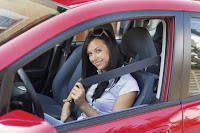Tag Archive: behind the wheel driving test

Tips for Proper Parallel Parking
July 14, 2011
Probably, the maneuver that most strikes fear in the heart of a new driver facing a behind-the-wheel driving test, is the parallel parking maneuver. Maneuvering your vehicle, backwards, into a tiny parking spot without hitting the vehicle ahead or behind is daunting even for experienced drivers who don’t have to do it very often but it doesn’t have to be all that scary. Just like any other skill, all it takes is practice…. lots and lots of practice.
You shouldn’t start practicing in a real environment with actual cars in front and back; making a mistake while learning to park around real cars could be costly. Instead, you should begin learning how to perform this maneuver in an empty parking lot with a pair of cones or some other type of marker to represent the front and rear bumpers of the car ahead and behind.
Step one – Illuminate your right turn signal to let other drivers know your intentions. Slow down and pull up alongside the other “car” (cone) until your rear bumper is even with the front vehicle’s rear bumper. Check your mirrors for other traffic and don’t begin until you are sure the way is clear.
Step two – Put the car in reverse and turn the wheel to the right. Turn the upper part of your body to the right so that you can clearly see everything behind you. Start backing slowly and steadily into the space behind. When your passenger door comes even with the rear bumper of the front vehicle, stop.
Step three – Turn the steering wheel to the left and continue backing into the space making sure you aren’t coming too close to the vehicle ahead or about to hit the bumper of the vehicle behind. Once your front bumper has completely cleared the vehicle ahead and your car is completely in the space, stop the car.
Step four – Now put the gear shift into drive and ease the car forward until you are completely centered in the space with enough clear space ahead and behind for you to get out later.
Step five – Put the car in park and get out to see if your car is fully centered. There should be roughly, an even amount of space between your vehicle and the vehicles ahead and behind. Your car should be facing straight ahead and not parked at an angle and the side of your car should be no more than 12 to 18 inches away from the curb.
Keep practicing this parallel parking maneuver over and over until it is second nature to you. With enough practice, you will be able to dazzle the DMV examiner with your skill and confidence.

Top 5 Hints for Passing the DMV Road Test
July 8, 2011
Picture the DMV road test: new driver in the driver’s seat, driving examiner-with-clipboard-in-hand sitting beside him in the passenger’s seat, giving instructions and with an ever-so-tight grip on a pen, taking notes. The driving exam can be grueling for new drivers who are worried about passing/failing — in other words, anxiety may become a factor in passing the driving road test.
Here are the top 5 hints for passing the driving road test:
1. Get lots of practice during your learner’s permit period. In most states, there is a required waiting period from getting a permit or intermediate license before a new driver is allowed to take the road test. This is essentially the state giving the new driver a chance to practice all the skills needed to pass the road test.
2. Obey signs/signals and avoid hitting the cones/curbs. Just because the driving examiner is writing notes on the examination form, that doesn’t mean that new driver has made a mistake. The examiner has to write down the good things as well as the bad. Minor mistakes are allowed but, if those minor mistakes add up to 30 points, you will fail the exam. There are several things that will cause you to automatically fail the exam. Failure to obey traffic signals/signs or hitting the cones/curbs while parking or conducting the three-point-turn are the most common reasons for an automatic failure. For the stopping part, there’s this 4-second-stop rule: to be sure that the car is in a complete halt, step down on the brakes and count to 4 to make sure that the car is totally stopped. For the parking segments, ask a family member (who is a valid license holder) to show you exactly how to park the right way and then practice it – – a lot! Practice the three-point-turn on a narrow street. Practice makes perfect.
3. Follow the examiner’s directions, while demonstrating the ability to make the right decisions. The driving examiner will not ask you any trick questions nor will he or she ask you to do anything that is illegal. Driving is tricky enough all by itself so they don’t have to try to trick you. The examiner will give you straight, simple instructions. Don’t look for the hidden meaning in the instructions; just do as he/she says. If you truly don’t understand the instruction, ask for clarification. It is better to ask than to try to guess and make a mistake. The stupid questions are the ones that don’t get asked.
4. Obey the state’s driving law. This one’s pretty simple, even with varying laws between states, there are still driving laws that are common to most. An example would be:
- Properly wearing a seatbelt before starting the vehicle.
- Properly yielding to other traffic when changing lanes.
- Properly giving a turn signal when turning, changing lanes, or turning into or backing out of a parking space
- Safe driving around school buses and school zones. (There will usually be signs to follow.)
- Knowing the meaning of a Yield sign. Slow and look for other traffic or pedestrians crossing your path and be prepared to stop if necessary. If the way is clear, keep going.
- Stop for pedestrians in a crosswalk.
- Don’t follow too close, maintain a two to three-second following distance.
5. Make sure you have all of the documents that will be needed. In order to take the road test, you will need a current vehicle registration slip that matches the dates on your tags. You will also need a current proof of insurance form. Both of these documents should be in the vehicle at all times. For proof of your ID to get a license, you will need a minimum of the following (check with your local DMV for a complete list):
- Birth Certificate with raised seal (or current passport)
- Social Security Card
- More than one proof of address, such as your parent’s electric or home insurance bills.
You will also need:
- A form signed by your parent of guardian showing you have received the necessary number of driving instruction hours for both day and night driving.
- Your parent’s written permission to receive a license (if under the age of 18).
- A certificate showing you have completed any state required driver education.
Master the Driving Maneuvers for the Road Test with a “Behind-the-Wheel” Online Simulator Course
